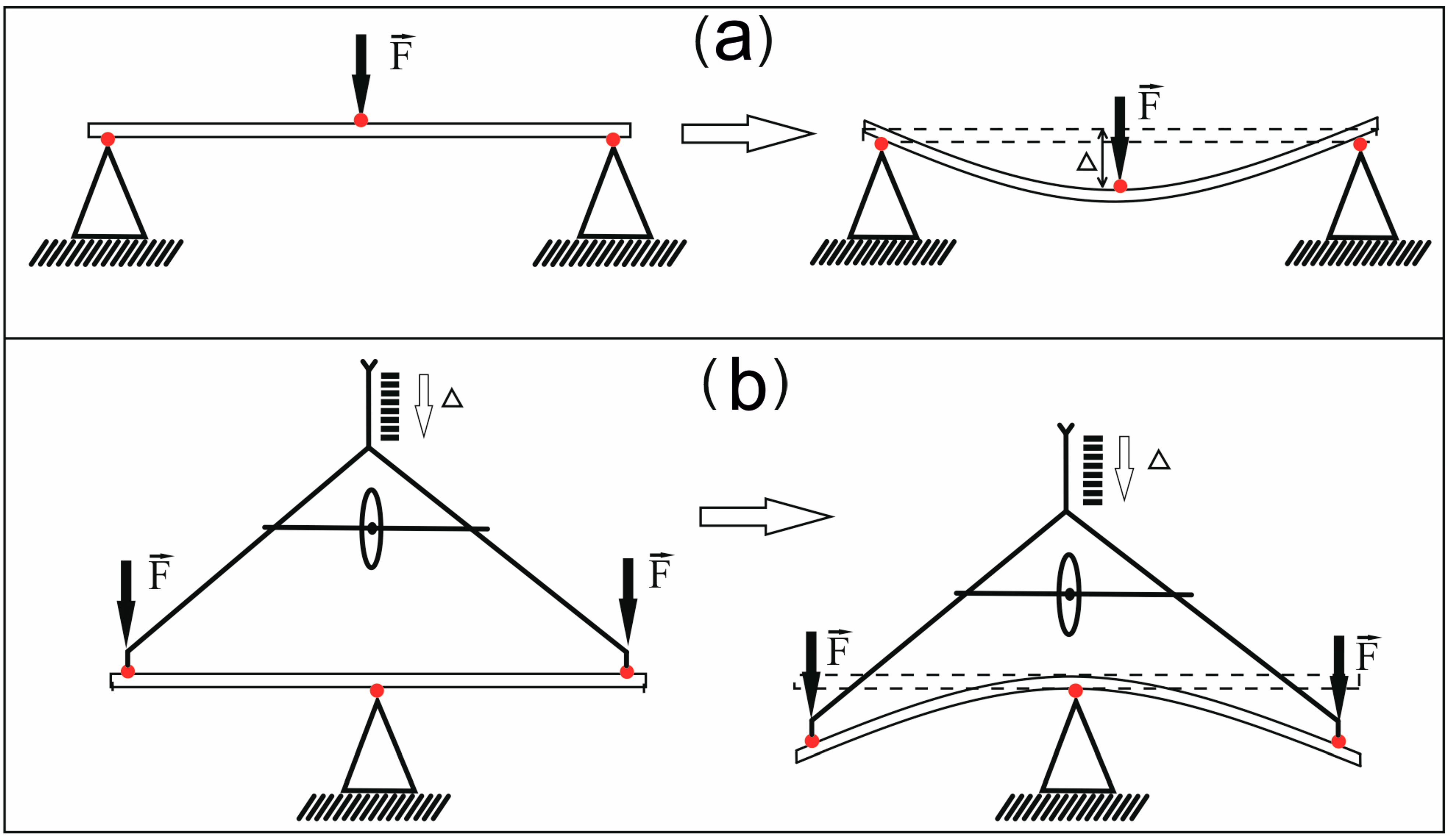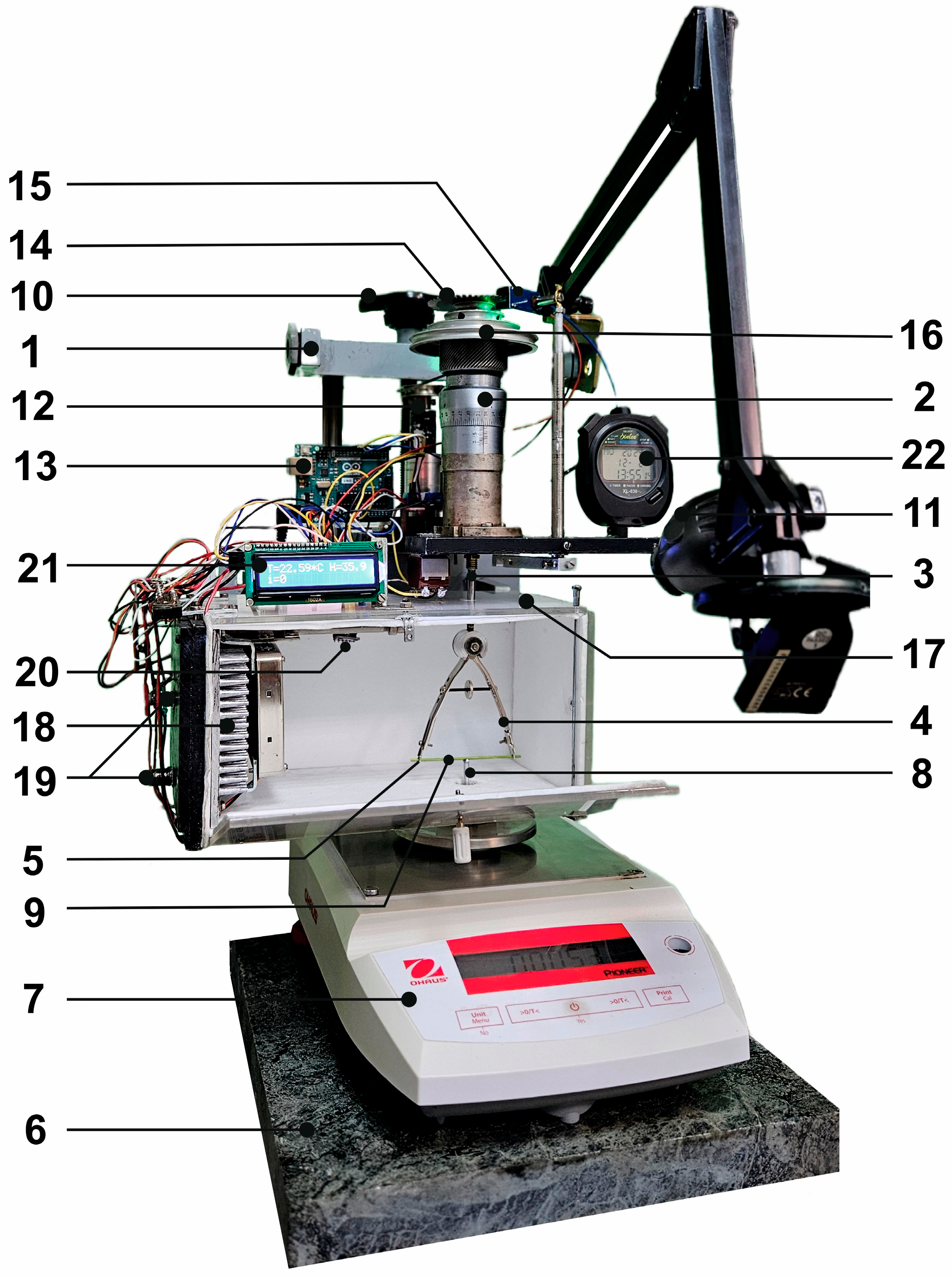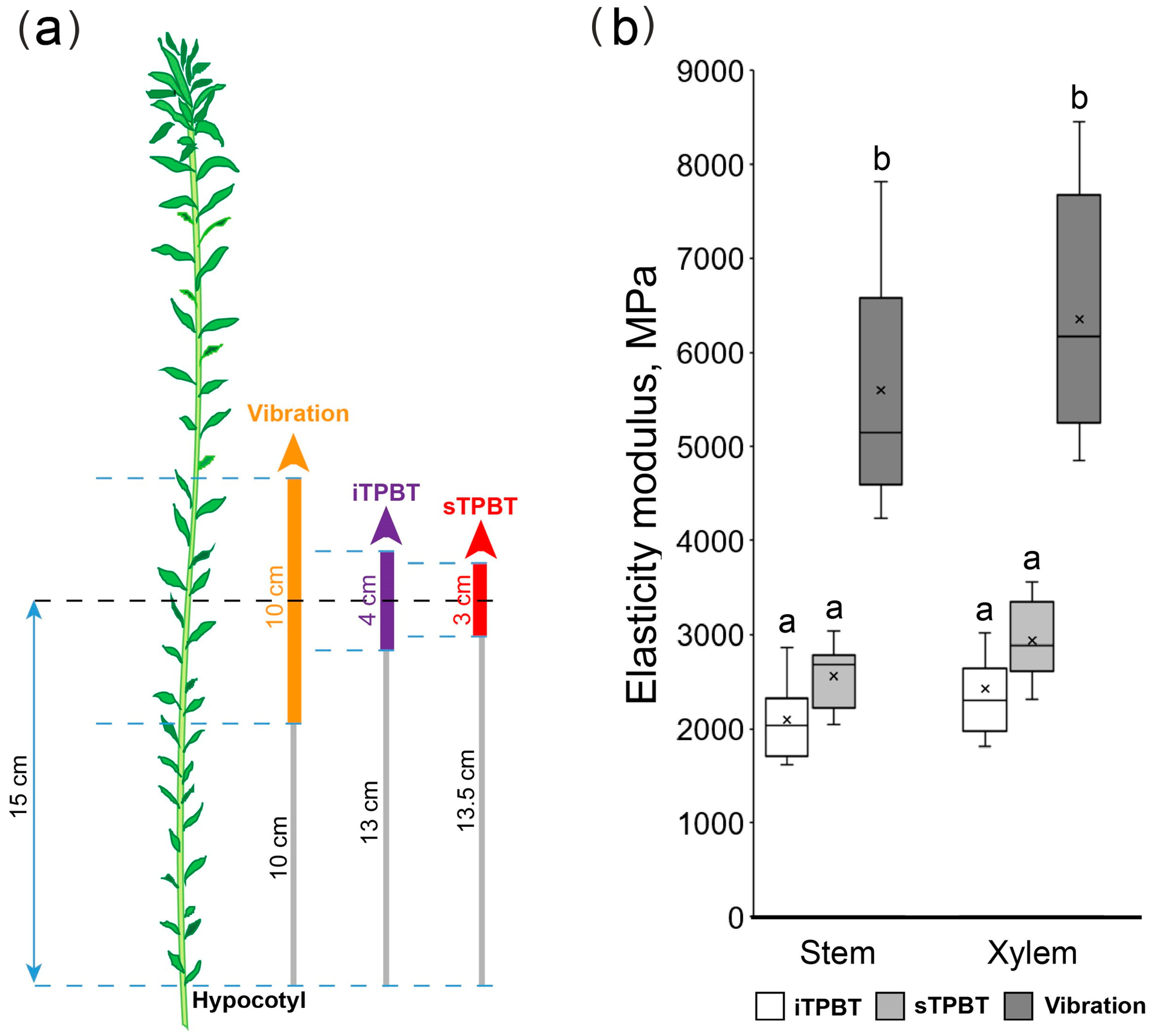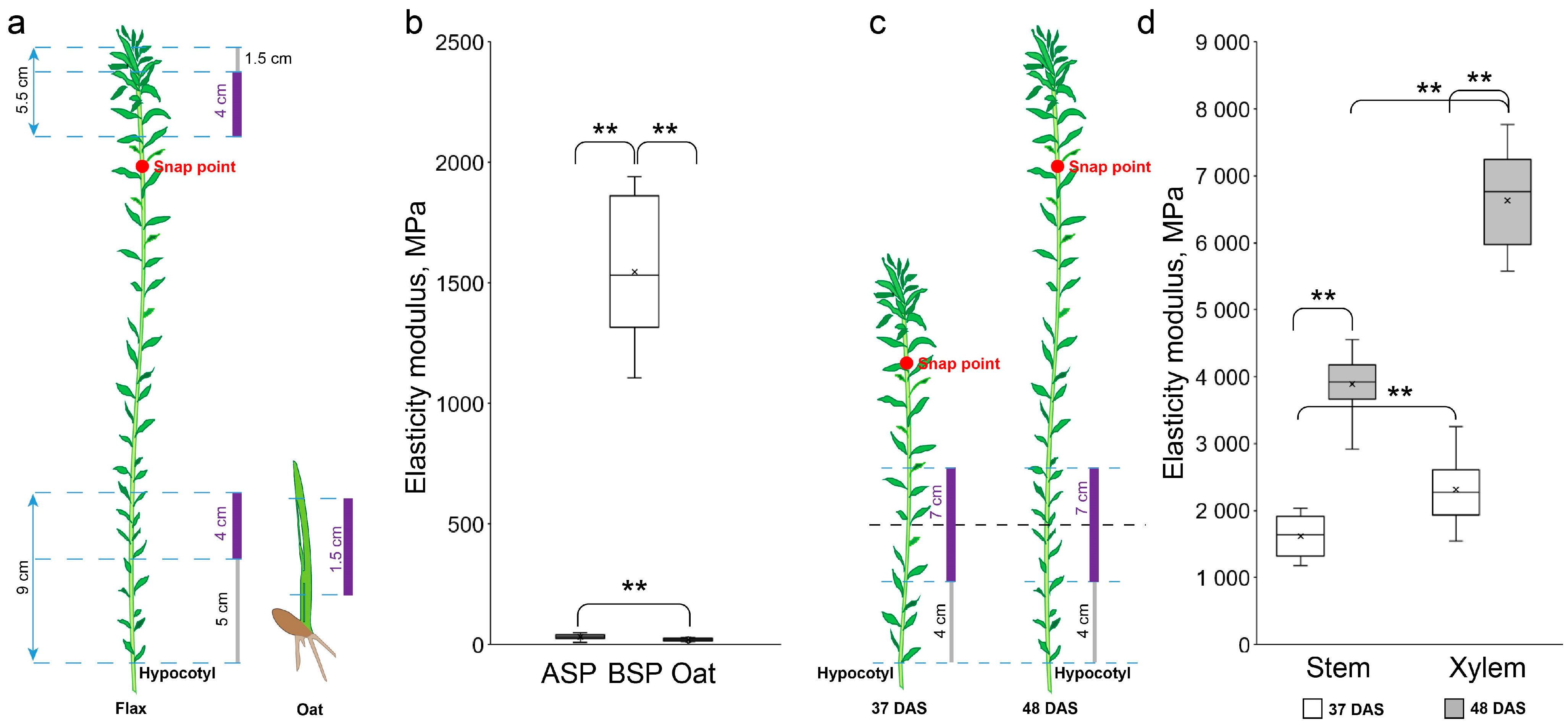Using the Inverse Three-Point Bending Test to Determine Mechanical Properties of Plant Stems
Abstract
1. Introduction
2. Material and Methods
2.1. Plant Material
2.2. Mechanical Properties Investigation
2.2.1. Inverse Three-Point Bending Test
2.2.2. Three-Point Bending Test with Rheometer
2.2.3. Vibration Method of Mechanical Properties Investigation
2.3. Statistics
3. Results and Discussion
3.1. Design of the Device for the Inverse Three-Point Bending Test
3.2. Test of the Device for the Inverse Three-Point Bending Test
3.2.1. Adequacy of Mechanical Property Values Obtained with the Device
3.2.2. Sensitivity of the Device
4. Conclusions
Supplementary Materials
Author Contributions
Funding
Institutional Review Board Statement
Informed Consent Statement
Data Availability Statement
Acknowledgments
Conflicts of Interest
References
- Niklas, K.J. Plant Biomechanics: An Engineering Approach to Plant form and Function; University of Chicago Press: Chicago, IL, USA, 1992. [Google Scholar]
- Speck, T.; Burgert, I. Plant stems: Functional design and mechanics. An. Rev. Mat. Res. 2011, 41, 169–193. [Google Scholar] [CrossRef]
- Cosgrove, D.J.; Jarvis, M.C. Comparative structure and biomechanics of plant primary and secondary cell walls. Front. Plant. Sci. 2012, 3, 204. [Google Scholar] [CrossRef] [PubMed]
- Burgert, I.; Keplinger, T. Plant micro- and nanomechanics: Experimental techniques for plant cell-wall analysis. J. Exp. Bot. 2013, 64, 4635–4649. [Google Scholar] [CrossRef]
- Moulia, B. Plant biomechanics and mechanobiology are convergent paths to flourishing interdisciplinary research. J. Exp. Bot. 2013, 64, 4617–4633. [Google Scholar] [CrossRef]
- Leblicq, T.; Vanmaercke, S.; Ramon, H.; Saeys, W. Mechanical analysis of the bending behaviour of plant stems. Biosys. Eng. 2015, 129, 87–99. [Google Scholar] [CrossRef]
- Geitmann, A.; Gril, J. Plant Biomechanics. From Structure to Function at Multiple Scales; Springer International Publishing: Cham, Switzerland, 2018. [Google Scholar] [CrossRef]
- Fournier, M.; Dlouha, J.; Jaouen, G.; Almeras, T. Integrative biomechanics for tree ecology: Beyond wood density and strength. J. Exp. Bot. 2013, 64, 4793–4815. [Google Scholar] [CrossRef]
- Pieruschka, R.; Lawson, T. Phenotyping in Plants. Preface. J. Exp. Bot. 2015, 66, 5385–5387. [Google Scholar] [CrossRef]
- Nakata, M.T.; Takahar, M.; Sakamoto, S.; Yoshida, K.; Mitsuda, N. High-Throughput Analysis of Arabidopsis Stem Vibrations to Identify Mutants With Altered Mechanical Properties. Front. Plant. Sci. 2018, 9, 780. [Google Scholar] [CrossRef]
- Goudenhooft, C.; Bourmaud, A.; Baley, C. Flax (Linum usitatissimum L.) Fibers for Composite Reinforcement: Exploring the Link Between Plant Growth, Cell Walls Development, and Fiber Properties. Front. Plant. Sci. 2019, 10, 411. [Google Scholar] [CrossRef]
- Bourmaud, A.; Shah, D.U.; Beaugrand, J.; Dhakal, H.N. Property changes in plant fibres during the processing of bio-based composites. Ind. Crop. Prod. 2020, 154, 112705. [Google Scholar] [CrossRef]
- Melelli, A.; Arnould, O.; Beaugrand, J.; Bourmaud, A. The Middle Lamella of Plant Fibers Used as Composite Reinforcement: Investigation by Atomic Force Microscopy. Molecules 2020, 25, 632. [Google Scholar] [CrossRef] [PubMed]
- Skubisz, G. Development of studies on the mechanical properties of winter rape stems. Int. Agrophysics 2001, 15, 197–200. [Google Scholar]
- Shah, D.U.; Reynolds, T.P.; Ramage, M.H. The strength of plants: Theory and experimental methods to measure the mechanical properties of stems. J. Exp. Bot. 2017, 68, 4497–4516. [Google Scholar] [CrossRef] [PubMed]
- Ampofo, J.; Ofori, E.; Ibrahim, A.A. Mechanical properties of plantain pseudostem and implications for susceptibility to lodging. J. Agric. Environ. Int. Dev. (JAEID) 2013, 107, 3–11. [Google Scholar] [CrossRef]
- Slater, D.; Ennos, A.R. Determining the mechanical properties of hazel forks by testing their component parts. Trees 2013, 27, 1515–1524. [Google Scholar] [CrossRef]
- Robertson, D.J.; Smith, S.L.; Cook, D.D. On measuring the bending strength of septate grass stems. Am. J. Bot. 2015, 102, 5–11. [Google Scholar] [CrossRef]
- Cosgrove, D.J. Measuring in vitro extensibility of growing plant cell walls. Methods Mol. Biol. 2011, 715, 291–303. [Google Scholar] [CrossRef]
- Nolte, T.; Schopfer, P. Viscoelastic versus plastic cell wall extensibility in growing seedling organs: A contribution to avoid some misconceptions. J. Exp. Bot. 1997, 48, 2103–2107. [Google Scholar] [CrossRef]
- Kohler, L.; Spatz, H.C. Micromechanics of plant tissues beyond the linear-elastic range. Planta 2002, 215, 33–40. [Google Scholar] [CrossRef]
- Abasolo, W.; Eder, M.; Yamauchi, K.; Obel, N.; Reinecke, A.; Neumetzler, L.; Dunlop, J.W.; Mouille, G.; Pauly, M.; Höfte, H.; et al. Pectin may hinder the unfolding of xyloglucan chains during cell deformation: Implications of the mechanical performance of Arabidopsis hypocotyls with pectin alterations. Mol. Plant 2009, 2, 990–999. [Google Scholar] [CrossRef]
- Zebrowski, J. Dynamic behaviour of inflorescence-bearing Triticale and Triticum stems. Planta 1999, 207, 410–417. [Google Scholar] [CrossRef] [PubMed]
- Skubisz, G. Method for the determination of the mechanical properties of pea stems. Int. Agrophysics 2002, 16, 73–77. [Google Scholar]
- Lemloh, M.-L.; Pohl, A.; Zeiger, M.; Bauer, P.; Weiss, I.M.; Schneider, A.S. Structure-property relationships in mechanically stimulated Sorghum bicolor stalks. Bioinspired Mater. 2014, 1, 1–11. [Google Scholar] [CrossRef]
- Zhdanov, O.; Blatt, M.R.; Cammarano, A.; Zare-Behtash, H.; Busse, A. A new perspective on mechanical characterisation of Arabidopsis stems through vibration tests. J. Mech. Behav. Biomed. Mater. 2020, 112, 104041. [Google Scholar] [CrossRef]
- Réquilé, S.; Goudenhooft, C.; Bourmaud, A.; Le Duigou, A.; Baley, C. Exploring the link between flexural behaviour of hemp and flax stems and fibre stiffness. Ind. Crop. Prod. 2018, 113, 179–186. [Google Scholar] [CrossRef]
- Petrova, A.; Zakharov, M.; Ageeva, M.; McKenzie, R.; Gorshkova, T.; Deyholos, M.; Kozlova, L. A flax mutant with impaired intrusive growth of phloem and xylem fibres demonstrates constitutive gravitropic response. Plant Sci. 2022, 323, 111399. [Google Scholar] [CrossRef]
- Petrova, A.; Kozlova, L.; Chernova, T.; Gorshkova, T. Development of the biomechanical system of the flax stem: Mutual game of primary and secondary growth. Ind. Crop. Prod. 2024, 209, 117979. [Google Scholar] [CrossRef]
- Gorshkova, T.A.; Sal’nikova, V.V.; Chemikosova, S.B.; Ageeva, M.V.; Pavlencheva, N.V.; van Dam, J.E.G. The snap point: A transition point in Linum usitatissimum bast fiber development. Ind. Crop. Prod. 2003, 18, 213–221. [Google Scholar] [CrossRef]
- Snegireva, A.; Ageeva, M.; Vorob’ev, V.; Anisimov, A.; Gorshkova, T. Plant fiber intrusive growth characterized by NMR method. Russ. J. Plant Physiol. 2006, 53, 163–168. [Google Scholar] [CrossRef]
- Niklas, K.J.; Spatz, H. Plant Physics; University of Chicago Press: Chicago, IL, USA, 2012. [Google Scholar]
- Sutherland, B.; Steele, K.; Carter, J.; Cook, D.D. The influence of water content on the longitudinal modulus of elasticity of maize stalk pith and rind tissues. Plant Methods 2023, 19, 64. [Google Scholar] [CrossRef]
- Hejnowicz, Z.; Sievers, A. Tissue stresses in organs of herbaceous plants: I. Poisson ratios of tissues and their role in determination of the stresses. J. Exp. Bot. 1995, 46, 1035–1043. [Google Scholar] [CrossRef]
- Kampowski, T.; Mylo, M.D.; Poppinga, S.; Speck, T. How water availability influences morphological and biomechanical properties in the one-leaf plant Monophyllaea horsfieldii. R. Soc. Open Sci. 2018, 5, 171076. [Google Scholar] [CrossRef] [PubMed]
- Ciupak, A.; Dziwulska-Hunek, A.; Gładyszewska, B.; Kwaśniewska, A. The relationship between physiological and mechanical properties of Acer platanoides L. and Tilia cordata Mill. leaves and their seasonal senescence. Sci. Rep. 2019, 9, 4287. [Google Scholar] [CrossRef] [PubMed]
- Fok, S.L.; Smart, J. Length effect of rods under three-point bending for determining the Weibull parameters of brittle materials. Probabilistic Eng. Mech. 1993, 8, 67–73. [Google Scholar] [CrossRef]




Disclaimer/Publisher’s Note: The statements, opinions and data contained in all publications are solely those of the individual author(s) and contributor(s) and not of MDPI and/or the editor(s). MDPI and/or the editor(s) disclaim responsibility for any injury to people or property resulting from any ideas, methods, instructions or products referred to in the content. |
© 2025 by the authors. Licensee MDPI, Basel, Switzerland. This article is an open access article distributed under the terms and conditions of the Creative Commons Attribution (CC BY) license (https://creativecommons.org/licenses/by/4.0/).
Share and Cite
Anisimov, A.; Suslov, M.; Petrova, A.; Chernova, T.; Gorshkov, O.; Gorshkova, T. Using the Inverse Three-Point Bending Test to Determine Mechanical Properties of Plant Stems. Methods Protoc. 2025, 8, 32. https://doi.org/10.3390/mps8020032
Anisimov A, Suslov M, Petrova A, Chernova T, Gorshkov O, Gorshkova T. Using the Inverse Three-Point Bending Test to Determine Mechanical Properties of Plant Stems. Methods and Protocols. 2025; 8(2):32. https://doi.org/10.3390/mps8020032
Chicago/Turabian StyleAnisimov, Alexander, Maksim Suslov, Anna Petrova, Tatyana Chernova, Oleg Gorshkov, and Tatyana Gorshkova. 2025. "Using the Inverse Three-Point Bending Test to Determine Mechanical Properties of Plant Stems" Methods and Protocols 8, no. 2: 32. https://doi.org/10.3390/mps8020032
APA StyleAnisimov, A., Suslov, M., Petrova, A., Chernova, T., Gorshkov, O., & Gorshkova, T. (2025). Using the Inverse Three-Point Bending Test to Determine Mechanical Properties of Plant Stems. Methods and Protocols, 8(2), 32. https://doi.org/10.3390/mps8020032





